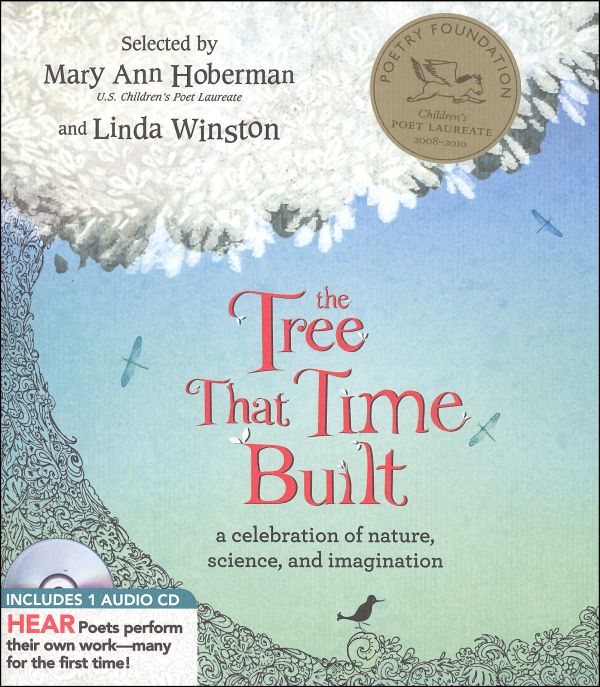
BIBLIOGRAPHY
Florian, Douglas. Poetrees. New York: Beach Lane Books, 2010. ISBN 9781416986720
PLOT SUMMARY
In Poetrees, Douglas Florian has created a poetry collection dedicated to all things tree—its seed, its bark, its roots and rings. His poems also go beyond tree anatomy to teach readers about a wide variety of tree species—among others, the baobab (“Vat tree. / Fat tree. / Bottle tree. / Brown tree”), the giant sequoia (“Grow by degrees / To world’s tallest trees”), and the bristlecone pine (“One of the oldest trees on Earth, / With swirling branches, twirling girth”). The book’s original format turns the book sideways to read top to bottom rather than left to right, and its original art was created using a variety of mediums on top of brown paper bags. The book includes a “glosatree” and a list of other tree resources for the blossoming arbor lover.
CRITICAL ANALYSIS
Douglas Florian has a strong sense of rhythm, and the arrangement of each poem’s meter and line reflects deliberate writing. In his first poem, “The Seed,” Florian uses a single, unbroken poetic line in the shape of the infinity symbol to deftly depict the never-ending cycle of the tree (and the seed and the tree . . . ). In “Coconut Palm,” Florian creates a short, bouncy ABAB rhyme scheme to echo the light tone of the poem’s text. In “Monkey Puzzle Tree,” Florian pens a true limerick, the perfect vessel for his humorous musings. Each of Florian’s poems has a rhythm that matches its tone, a true feat in the poetry world. Furthermore, Florian’s poetry never feels forced and his poems hold to an unfaltering rhythm, reminiscent of the unfaltering stability of trees.
The design of the book itself is also commendable. The pages turn vertically, allowing trees to reach great heights on the paper. But the quality of the illustrations themselves is a mélange. Some reflect the mood of the poem exceptionally well. (These include “Giant Sequoias” with its breathtaking collage of ecological coexistence, and the gorgeous watercolor circles in “Tree Rings” which complement the wonder of discovering a tree’s history.) However, some illustrations are so bizarre that they make otherwise strong poems seem at best badly matched with their visual counterparts and at worst unappealing. (These include “Roots,” paired with an unsettling and seemingly random brown watercolor of a shirtless man, and “Banyan,” accompanied by underdeveloped tree outlines and a strange Weiner-dog-esque creature lying at the root).
As for the language of Poetrees, one characteristic of the collection is the ample use of the pun. In fact, puns can be found in almost every poem in the collection, in both the poetry itself (cold-climate paper birch is renamed “paper birrrrrrrrrrrrrch”) and in the illustrations (dogs peek out from underneath the “bark”). While clever puns are sure to delight clever children, on occasion the puns feel too ample. In “Japanese Ceder,” for example, the puns “ex-seed-ingly” and “tree-mendous” are repeated five times in the short ten-line poem, making it seem more trite than witty. Occasionally, Florian produces poetry that feels underdeveloped. Take “Oak,” for example, with its four short lines—“From the acorn / Grows the tree— / Slowly, / Slowly.” In summary, Florian’s Poetrees shows a grasp of rhythm and rhyme, but the illustrations and language aren’t consistent enough to merit true excellence.
AWARDS AND REVIEW EXCERPTS
From School Library Journal: “This exquisite collection, with its thoughtful wordplay and timely subject, rewards careful reading and should resonate with a wide audience.”
From Horn Book Magazine: “Trees need all the help they can muster in today’s world; this quirky entry may well enlist interest.”
From Booklist: “Starting with the book’s title and ending with a final glossatree, the wordplay in Florian’s latest poetry collection provides plenty of fun.”
From Kirkus Reviews: “Trees receive a witty and informative rhyming appreciation. . . . Although some of [Florian’s] wordplay falls flat (sequoias are “Ancient seers / Of three thousand years”), by and large the poems live up to his usual high standard. . . . Readers and listeners will learn and laugh.”
CONNECTIONS
- Read the shape poem “Tree Rings” together. Then invite children to create shape poems of their own.
- Show children a local field guide of trees and go on a neighborhood walk together, allowing children to collect leaves, seeds, and bark. Then, use the book to identify tree species together and create a “neighborhood tree guide” by pasting leaves and seeds onto paper and writing the species name underneath. The following book could be a helpful reference:
- Gibbons, Gail. Tell Me, Tree: All About Trees for Kids. ISBN 9780316309035
- Read excerpts from Poetrees with other excerpts from Douglas Florian. Ask children which book or poem is their favorite and why.
- Florian, Douglas. Comets, Stars, the Moon, and Mars: Space Poems and Paintings. ISBN 9780152053727
- Florian, Douglas. Insectlopedia. ISBN 9780152163358
- Florian, Douglas. Winter Eyes. ISBN 9780688164584
- Read Poetrees with other picture books about trees. Then, ask children to write and illustrate their own tree story.
- Napoli, Donna J., and Kadir Nelson (illustrator). Mama Miti: Wangari Maathai and the Trees of Kenya. ISBN 9781416935056
- Hopkins, H. J., and Jill McElmurry (illustrator). The Tree Lady: The True Story of How One Tree-Loving Woman Changed a City Forever. ISBN 9781442414020
- Zweibel, Alan, and David Catrow (illustrator). Our Tree Named Steve. ISBN 9780142407431
*Note—This book review was created as an assignment for a course at Texas Woman’s University.
